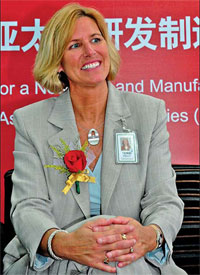Gore goes beyond making material commitment
W. L. Gore & Associate Inc, manufacturer of GORE-TEX and thousands of other advanced products, earlier this month announced it would construct a new 21,700-sq-m facility and also renovate 6,000 sq m of recently leased space in Shenzhen, Guangdong province. The Newark, Delaware-based firm's new $30 million facility would be located adjacent to its existing fabric and electronics manufacturing plant, which it opened in 2002 with a $10 million investment.
Construction of the new site, slated for completion in 2010, is part of a long-term commitment to expanding Gore's R&D and manufacturing capabilities in Shenzhen.
Once the plant opens, Gore would own more than 21,700 sq m and lease 27,100 sq m of space in the city's Futian Free Trade Zone. The company, which posted nearly $2.5 billion in sales in 2008 and employs 8,000 people at 45 facilities worldwide, is looking to expand its China presence.
China Daily reporter Hu Yuanyuan talked with Gore's global president and CEO Terri Kelly about the firm's China operations.

Q: How do you expect the new R&D center and manufacturing plant to fuel your business growth?
A: Gore Shenzhen's sales for 2006 were $52 million, and we expect sales exceeding $100 million by the fiscal year of 2010. In fact, Gore Shenzhen will be the manufacturing center for Gore's Asia-Pacific business. And the new plant is also the biggest investment we've ever made in the Asia-Pacific region.
Q: In addition to fabric, Gore has three major focuses: electronic, industrial and medical products. Will the new investment enable you to hasten your expansion in these three sectors?
A: Yes. The new plant will manufacture a number of industrial products, and we've already got approval for some medical products. But, for the time being, fabric is still the major product in Gore Shenzhen, accounting for 85 percent, and the remaining 15 percent goes to electronic products, which we started producing in early 2004.
The added hi-tech R&D and manufacturing capabilities will support the growing variety of Gore business activities in the region. Our vision is to create a campus-like setting in which the support infrastructure for several business units are located adjacent to one another, offering "associates" - as Gore employees are known - greater opportunities for career development, including cross-functional training and exposure to the company's broad range of capabilities.
Q: What proportion of your business portfolio does Gore China account for? And what is your expectation for your China business' growth in coming years?
A: Currently, 10 percent of Gore's revenue comes from the Asia-Pacific region, and we would like to see the number grow to 25 percent within 10 years, and China will be the largest contributor to this.
Q: It seems as if Gore mainly relies on organic growth in China. Would you also consider merger and acquisition opportunities to fuel your growth?
A: We did some mergers and acquisitions but mainly on the technology side. But generally, we largely rely on organic growth to promote our business.
Q: What are Gore's striking advantages compared with your major rivals in the Chinese market?
A: Well, there is almost no direct competitor with Gore in the China market, as we are very focused on a niche market, which is tailored for the most demanding customers. Of course, there are a number of international and local manufacturers producing similar products, but they usually target mid-range and low-end customers and offer a wider range of products. Besides, Gore also provides a complete package of services ranging from direct customers to end-users.
Q: What, then, is your greatest challenge in tapping the China market?
A: Well, the biggest challenge may lie with our branding. A lot of people know GORE-TEX, but few know W. L. Gore & Associate Inc, the manufacturer of GORE-TEX. So, we would like to do more in promoting the company Gore itself.
Q: As fabric manufacturing usually produces pollution, has Gore China made efforts to ensure its plants and products are environmentally friendly?
A: Yes, we do. Although our emission of VOC (volatile organic compounds) is completely up to relevant requirements, we still invested 5 million yuan in introducing a RTO system from the US, which can digest 98 percent of VOC. And the annual operational cost for this equipment hovers around 2 million yuan. The whole set of equipment has been in place since June 2007, making Gore the first manufacturer to adopt such equipment in Shenzhen.
Q: Gore has developed a reputation for providing an exceptional workplace. The firm appears on every listing of the "100 Best Companies to Work for in America" and "Best Companies to Work For" in Europe. How have you achieved this?
A: That is mainly attributed to the "lattice" structure in Gore - a team-based environment that encourages personal imitative and person-to-person communication among all "associates", as employees are known. In addition, Gore tries to keep its teams small and caps even its manufacturing plants at 200 people. That way, everyone can get to know one another and work together with minimal rules, as though they were a taskforce tackling a crisis.
(China Daily 05/29/2008 page15)














